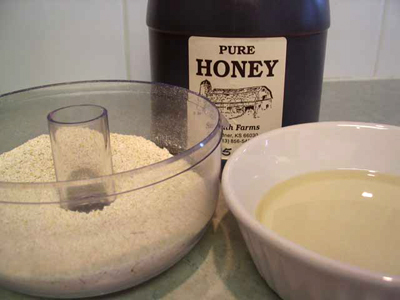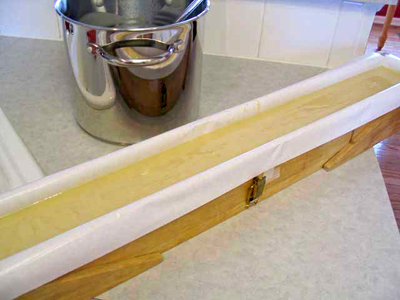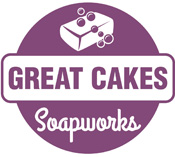How to Make Goat’s Milk Soap
Today I made some Oatmeal, Milk and Honey soap. My basic recipe is 45% soft oils, 40% hard oils, and 15% butters, with a 4% superfat because the goat’s milk also adds fats. The amount of milk is about twice the amount of lye. This method is not for beginners, but you can use an online soap calculator such as SoapCalc to figure out a recipe with the ingredients that you have or like. I added some pulverized rolled oats (do not use quick oats!), some local honey, and some Oatmeal, Milk and Honey fragrance oil.

Making soap with goat’s milk is a little bit different than using water. The lye heats up whatever liquid you add it to, so there are several things you need to do to prevent the goat’s milk from being scorched by the lye.
The first thing I do is melt all the oils and cool them down to around 80-90 degrees fahrenheit.

Another thing I do is freeze all the goat’s milk in ice cube trays.

When the lye is added to the frozen milk, it will melt it. You have to be sure to stir it really well to get the lye completely dissolved. The best way I’ve found is to scrape down the sides of the bowl with a silicone spatula and keep stirring until the temperature of the lye solution is around 80-90 degrees fahrenheit as well. If the lye solution is too cool, you can get pockets of undissolved lye in your soap. This is a great time to have your goggles, rubber gloves and apron on!

Once the lye is fully dissolved, it’s time to add it to the oils. I use my stick blender to mix them. When the mixture starts to thicken, I add the oats, honey, and fragrance and mix some more.

I like to pour my soap when it is still pretty thin – about like pancake batter. Once it is in the mold, I cover the top with plastic wrap and tape it down.

I used to prevent gel in my goat’s milk soap by putting a fan on it. Some soapmakers will put the soap in the refrigerator or freezer at this point. My mold won’t fit in either, so this worked for me.

I have since decided that I like my goat’s milk soaps to gel, so I will insulate with a towel or two, then cut the soap into bars in a couple of days after it has a chance to set up and isn’t too sticky. You can see more information and comments about gelling vs. non-gelling goat’s milk soaps here.
If anyone has questions or comments, I’d love to hear them!
This post was updated on January 16, 2012.
Page with Comments
Comments are closed.

@Toni – That question is beyond me. I’ve never attempted to make soap with wood lye – seems too unpredictable!
@Jodi – Absolutely! You can use any kind of milk to make a milk soap! Same method applies.
Hi,
I want to make a goat milk soap that is very light in texture almost kind of translucent. I can get fresh goat milk from a farm near by. I have been using
olive, coconut and soy. I find it lighter in colour if I use soy ( shortening) rather than palm. I have tried higher amounts of soy or higher amounts of olive oil. It seems lighter with the higher amount of olive. I use only goat milk.
Do you think if I used half goat milk half water it would be more translucent?
Any suggestions? Thank you very much.
@Leslie – That would probably help, but it would also take away those fabulous properties that you get from the goat’s milk. I’m curious as to why looks are trumping performance?
My goatmilk, honey and oatmeal soaps are always sticky and soft. Are they supposed to be that way? I assumed it was the honey. They seem to always mess up when I cut them because they are still soft. The last time, I even did a 10% liquid reduction and had the same sticky mess. I like the creaminess but hate to wait to cut my soap. Seems when I WANT soap to gel, it doesn’t. Any suggestions?
@Shelia – Without knowing your recipe, I can’t say for sure why your soap is sticky & soft. I would imagine you may be using too much honey, although the sugars in the honey usually overheat the soap, so I’m not sure why it isn’t gelling. Forcing gel is pretty easy – just cover your soap with towels or blankets. I would reduce the superfat to 3 or 4% since there are fats in the goat’s milk and see what happens.
I have now made 4 batches of GM soap and am hooked! I am learning something new with each batch. It makes me feel good to read the problems and solutions posted. I feel like I’m not the only one having difficulties. It’s a learning process. I was surprised to learn that using palm oil might cause stearic acid reaction. I will switch to palm kernel oil.
I tried my first batch of soap this past weekend, did 100% coconut soap, 20% superfatted, and goats milk. I let it gel (live in the tropics and super easy for soap to gel…had to put it in the fridge as I was afraid of overheating), and it looks amazing! i’m officially hooked!!! been all over your blog for inspiration!
That’s great, Ni!! You are ready for many more!! 🙂
I recently made my first goat milk soap. It’s very creamy and moisturising. I like it very much.
Wow, that’s a super long mold! I think mine is about 1/3 shorter. I was thinking of cutting my next mold in half. One question . . . do you ever have problems with your soap thickening up too fast when adding color or fragrances? That’s one reason I want my next molds to be shorter. Any suggestions? Thanks in advance!
My first batch of Honey Oatmeal Milk soap turned out a little sticky as well, but seems to be getting better during the curing. I didn’t have goat milk at the time so I used buttermilk. I added almond fragrance and it smells wonderful! I experimented by putting one mold in the freezer for about six hours and then left it in the fridge overnight. I left the second mold wrapped on my shelves. The one from the fridge remained a nice creamy color. The one on the shelf gelled and was a nice golden color, but had a fair amount of soda ash on the top and part way down one of the sides. Any idea on what would have caused this? I like both the gelled and non-gelled versions, but would like to know how to prevent the soda ash.
@Donna – Yes, the soap will trace faster because of certain colors or scents. Ultramarines, oxides (including titanium dioxide), and clays all seem to encourage the soap to set up faster. Spicy and floral scents will do the same thing. You can dilute your scent with some of your soaping oils, or even add the scent to the oils before you add the lye solution. Keeping your temps low – around 85-90 degrees can also help. Your recipe can also affect how fast your soap sets up. More hard oils = faster tracing soap, with the exception of lard.
@Donna – Soda ash is a strange beast. The best way I’ve found to prevent it is to lay plastic wrap on top of the fresh soap to seal out the air. You can also spritz the fresh soap with some rubbing alcohol before covering it if you don’t want to mess up your tops with plastic wrap, which helps some.
Hello All: I’m sooooooo!!! excited. Made my very first batch of goat’s milk soap. They turned out greeeeeeeat…really great. I was worried they would be dark, but they came out a very pretty very light beige. The key was keeping the goat’s milk cool. In my process it never heated to over 80. I also kept the molds (6-cavity silicone) in the freezer until I was ready to pour. This morning I the came out of the molds so very easy. I’m just so excited about getting the color I was hoping for. Newbies..don’t be afraid just keep the milk cold. Freeze it for a day or two before using.
Love this site. Thanks for answering my questions.
@Too Blessed – That’s fantastic!! I’m so glad it came out so beautifully! 🙂
Can I put my goat’sm milk soap on paper towels during the curing stage. I don’t know if it’s because the weather has been humid the past couple of days . I check them this morning and some seem a bit shiny/oily..Is this a normal part of the curing process? I took the up and placed paper towel on the rack and put them back. Is this ok? Any suggestions? Thanks
@Too Blessed – Normally, cold-process soap should NOT sweat. I don’t know how humid it is where you are, but definitely keep an eye on them, and maybe put a fan on them to see if that helps.
Hi Amy: Thanks for your answers. I wan to shrink wrap my goat’s milk soaps, but wonder if the heat sealing process will damage the soaps in any way. My other option is cello bags. Which of the two choices is the best, or do you have any suggestions?
Thanks,
Too Blessed To Be Stressed
@Too Blessed – I use my smell-through shrink wrap. It allows the soap to breathe just a bit, and the heat sealing process isn’t warm enough to damage the soaps in any way. http://www.greatcakessoapworks.com/products/smell-through-shrink-wrap
Today I made G.M. soap, I slowly added lye crystals to the frozen goats milk… I had a hard time getting the temp to 80’s I guess the frozen milk was too large of a chunk. I had my oils (olive, palm kernel, coconut oil and shea butter) in the 90’s. Blended and it did thicken to trace and I poured into my silicone mold lined box.
Question: Can someone offer the temps they strive for before mixing the lye/milk and oil. It was white when poured & thick like pudding but I am not certain what it will look like once it sits for a couple days before cutting.
I have made about 100 batches of soap, CP method but I am new to the goat’s milk process.
Any tips is appreciated!!!
@MiTer – There’s no magic temperature. As long as the milk is white or even slightly yellow and not orange and burnt it will turn out just fine!
Hi I am ready to make some goats milk soap, I have read and read many recipes, I would like to add essential oils to mine,(my husbands favorite) will that alter your recipe if I add some? thank you!
@Jeryl – Not at all! Just make sure you are using pure essential oils that have not been diluted with a carrier oil. Anything spicy like cinnamon or clove can make your soap set up super fast, so you probably want to avoid those for your first batch. Also citrus oils like sweet orange, lime, lemon, grapefruit will fade in cold-process soap if they aren’t folded. If you have questions about the oils you plan to use, just ask!
As a general rule of thumb (since I know each recipe changes things), how long do you like to cure soaps before you package and wrap them? I typically about 48 or more hours after pouring the batch and then I wait like a month before packaging it. I’m curious about soon can packaging be done without messing up the fresh air cure.
@Talina – I definitely wait a good four weeks before packaging. Most of my soaps are in custom boxes with a hole in the front, so the air can continue to circulate.
@ Melani If you force your soaps to gel, you won’t need to add beeswax to your soaps for hardness.
Hi, question….can I use charcoal along with goat milk in the soap or would that be overkill to the anti-bacterial properties? Would appriciate any help….
@Anita – I haven’t made a soap with goat milk and charcoal before, but it sounds like a lovely combo! Just know that you cannot claim that your soap is antibacterial as this implies a drug claim.
I froze my goat’s milk without measuring it out. Can I still measure it out the same when frozen
@Ruth – Yes, definitely! That’s almost always how I do it. 🙂